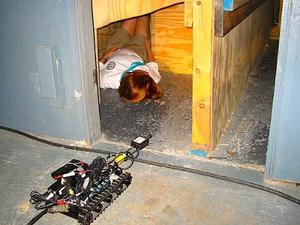Emergency evacuationRobots help evacuate buildings, search for trapped people
Two Georgia Tech engineers designed an emergency robot to help people evacuate buildings in an emergency; they say that emergency robots pacing the hallways and instructing people how to get to the emergency exits is a better solution than static emergency instructions placed on the wall; the robots will also search for injured or trapped people who failed to evacuate the building

Robot stays with victim during testing // Source: wired.com
Smokes fills the halls, ear-piercing alarm sounds, people leave their offices in a panic not knowing what to do. Two Georgia Institute of Technology researchers — Ayanna Howard and Paul Robinette, electrical engineers at the Georgia Institute of Technology in Atlanta – say: follow the robot.
The two engineers say that robots would be a better solution in a crisis than emergency instructions on static signs attached to walls. In an emergency, we want people to move as fast as they can toward emergency exits, and standing in the hallways to read instructions may not be a good idea under the circumstances. Also, the hall may fill up with smoke, s people need to move out of them.
A Georgia Institute of Technology release reports that the Howard and Robinnette argue that emergency robots pacing the hallways and instructing people how to get to the emergency exits is a better solution. They say that the robots should be at least as tall as a human, so that they can be seen in a crowd, and styled after familiar exit signs with lights and arrows to guide the way. The researchers have created two possible designs.
They propose that teams of these robots would be stored in large buildings and receive instructions from a human operator during an emergency. A robot would start in “rescuer mode,” searching for people in need of help, and then change to “leader mode” when it finds people it can guide to safety. If a robot comes across an injured person, it will make their location known to emergency personnel and stay with them to act as a communication device.
